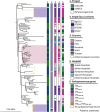International and regional spread of carbapenem-resistant Klebsiella pneumoniae in Europe
- PMID: 38877000
- PMCID: PMC11178878
- DOI: 10.1038/s41467-024-49349-z
International and regional spread of carbapenem-resistant Klebsiella pneumoniae in Europe
Abstract
Carbapenem-resistant Klebsiella pneumoniae (CRKP) are of particular concern due to the spread of antibiotic resistance genes associated with mobile genetic elements. In this study, we collected 687 carbapenem-resistant strains recovered among clinical samples from 41 hospitals in nine Southern European countries (2016-2018). We identified 11 major clonal lineages, with most isolates belonging to the high-risk clones ST258/512, ST101, ST11, and ST307. blaKPC-like was the most prevalent carbapenemase-encoding gene (46%), with blaOXA-48 present in 39% of isolates. Through the combination and comparison of this EURECA collection with the previous EuSCAPE collection (2013-2014), we investigated the spread of high-risk clones circulating in Europe exhibiting regional differences. We particularly found blaKPC-like ST258/512 in Greece, Italy, and Spain, blaOXA-48 ST101 in Serbia and Romania, blaNDM ST11 in Greece, and blaOXA-48-like ST14 in Türkiye. Genomic surveillance across Europe thus provides crucial insights for local risk mapping and informs necessary adaptions for implementation of control strategies.
© 2024. The Author(s).
Conflict of interest statement
The authors declare no competing interests.
Figures





References
-
- Bush, K. Past and present perspectives on β-Lactamases. Antimicrob Agents Chemother. https://www.ncbi.nlm.nih.gov/pmc/articles/PMC6153792/ (2018). - PMC - PubMed
MeSH terms
Substances
Grants and funding
LinkOut - more resources
Full Text Sources
Medical

